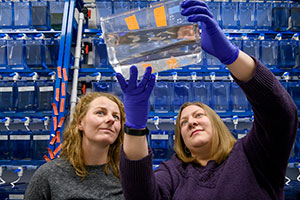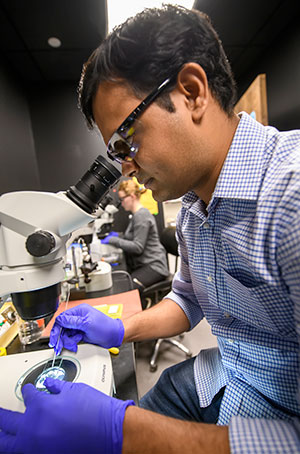
Spinal cord injury can result in mild to permanent dysfunction of the human body, including partial or complete paralysis. Rehabilitation may take years and can involve treatment from many health care disciplines.
Karen Mruk, an assistant professor of pharmaceutical science in the University of Wyoming's School of Pharmacy, is using a diminutive fish from southern Asia to research ways to help people recover from such injuries.
Mruk serves as principal investigator of the Mruk Lab, housed in the pharmacy wing of the UW College of Health Sciences. The lab opened in fall 2019, and its research mission is to advance the understanding of spinal regeneration using zebrafish, with implications for treating spinal injury in humans.
Unlike humans, zebrafish can regenerate their spinal cords. Mruk and other researchers hope the insights they gain from studying the fish can be applied to find ways to regenerate human spinal cord tissue.
"The Mruk Lab studies neural injury using the highly regenerative zebrafish larvae," Mruk says. "Larvae are an ideal model to study migrating cells, as they are both genetically tractable and transparent."
Zebrafish are a freshwater fish belonging to the minnow family. Because they are native to southern Asia, bringing these specimens to study in a cooler climate at Wyoming's high altitude presented challenges.
"We were definitely concerned with the altitude, but our colleagues at Stanford University were patient with maintaining our lines until we could get up and running," Mruk says.
Kirsten Underwood, from Bishop, Calif., is a second-year pharmacy student working in the Mruk Lab. Underwood co-wrote a grant proposal that resulted in the Mruk Lab being accepted to the Howard Hughes Medical Institute (HHMI) Janelia Research Campus' Advanced Imaging Center (AIC). The lab will use the AIC's SiMView light sheet microscope, which contains multiple objectives to illuminate and capture images from both sides, while creating a three-dimensional image.

"I have really enjoyed the opportunity to pursue research through the UW School of Pharmacy honors program. I have a lot of creative freedom to chase the biology I am excited about," Underwood says. "I remember hearing about Janelia as an undergrad, and I never thought I would have the opportunity to pursue that level of research here at the University of Wyoming."
The expanded curriculum of UW's WWAMI Medical Education Program includes a course in "Mind, Brain and Behavior" that Mruk directs.
"We are extremely fortunate to have a nationally renowned scholar such as Dr. Mruk leading one of our WWAMI courses," says Tim Robinson, director of the WWAMI (Washington, Wyoming, Alaska, Montana and Idaho) Medical Education Program at UW. "Dr. Mruk's lab is getting the attention of WWAMI students throughout our five-state region, as she will be mentoring a student from Seattle this summer. Part of offering a world-class medical education curriculum is the ability to provide high-caliber research projects for our medical students."
SiMView's imaging technology will allow faculty and student researchers to better understand how zebrafish cells move and interact with one another in 3D. In addition, the Mruk Lab will benefit from the AIC's expertise in using customized software to analyze cell movement.
"This award highlights the importance of Dr. Mruk's cutting-edge research and is another example of our faculty's commitment to student development," says Kem Krueger, dean of the UW School of Pharmacy. "I am very proud of the Mruk-Underwood team and know that this opportunity with the HHMI Janelia Research Campus will significantly advance their research program."
Jointly supported by the HHMI and the Gordon and Betty Moore Foundation, the AIC makes imaging technologies developed at Janelia available to the scientific community before commercialization. Scientific investigators from nonprofit organizations anywhere in the world may apply to use the facility.
"We are extremely excited about the research being conducted in Dr. Mruk's lab," says UW College of Health Sciences Dean David Jones. "We anticipate that this research will have a significant impact regarding our understanding of spinal cord injury, and it will contribute to the development of more effective approaches to treatment and rehabilitation."






